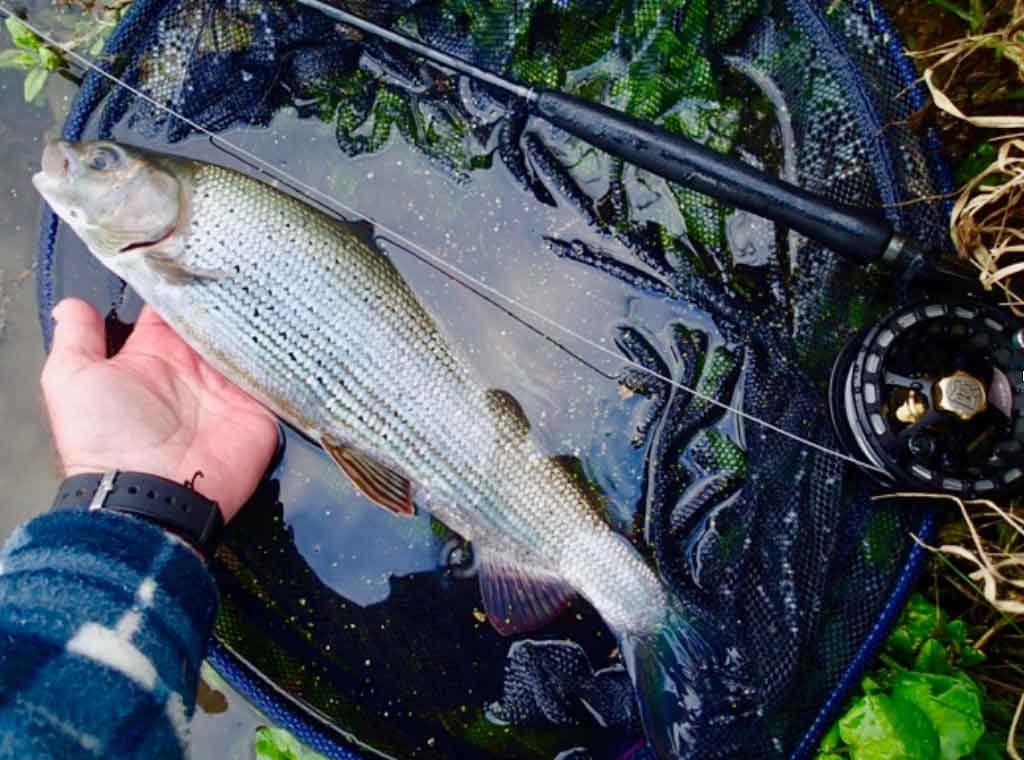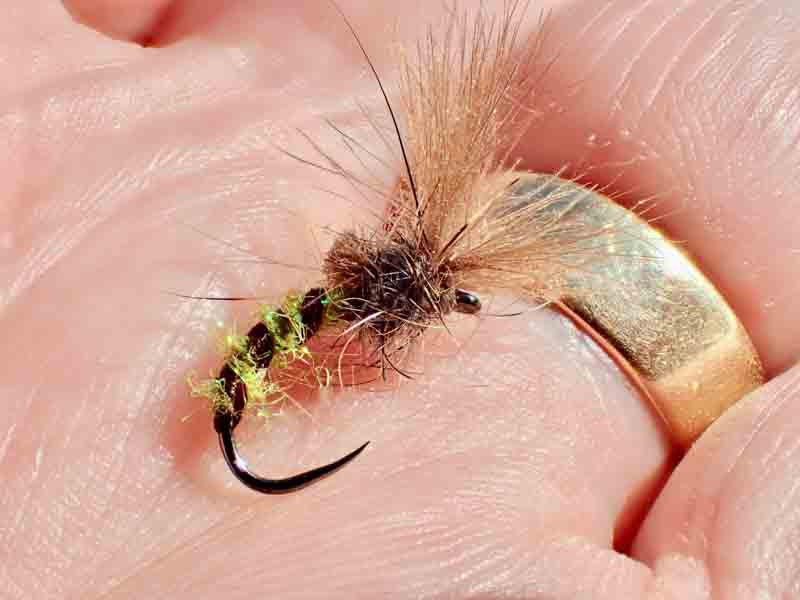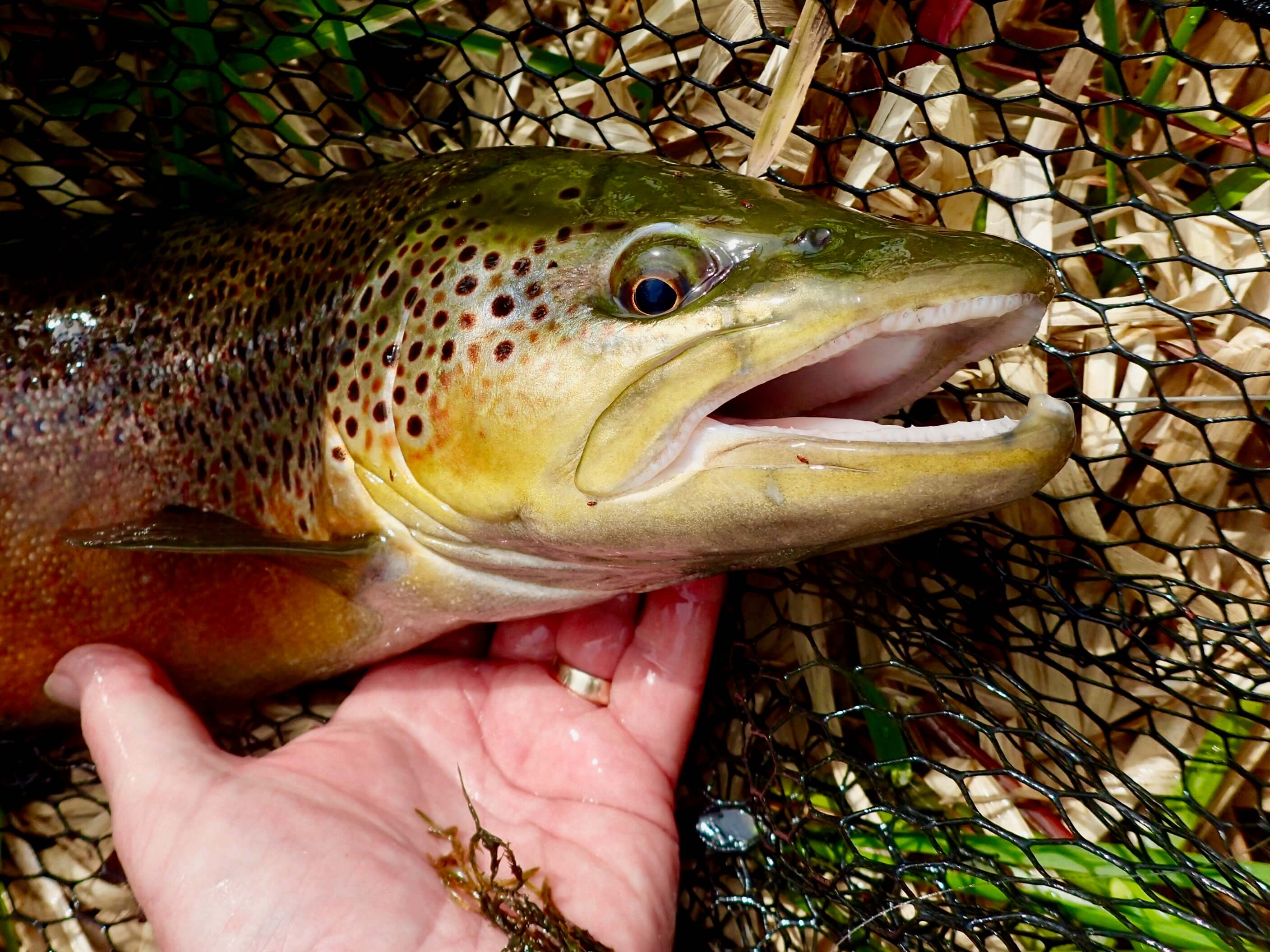by Dave Southall
My favourite methods of fly fishing are dry-fly or sight-fished nymphs/bugs, but particularly during the winter, when fishing on spate rivers, the grayling are usually loath to rise to a dry fly and the water is too coloured, or the light too poor, to see the fish for sight-fishing. It is then that I resort to a range of nymphing techniques. Of which Euronymphing is my most used technique
Short-line Euronymphing
This is the method I use when fishing areas of river with decent flows (walking pace and faster). And particularly in pool heads where fast, shallow riffles drop into deeper water. In such places the surface flow is significantly faster than the subsurface flow where the grayling (and trout) are sitting. Although both trout and grayling will often rise up from the riverbed when the water is relatively warm, it is generally essential to get one’s nymphs/bugs down close to the riverbed. Tungsten Bead-head Nymphs and Bugs, and Shrimps with lead under-bodies facilitate the fast sinking required. This can be aided by the use of 2 or even 3 weighted flies, rather than 1, plus the use of thin tippet and dump casts to put slack in the tippet when it lands.
Once the flies have reached the depth at which the fish are feeding it is important that the faster surface current does not drag them more rapidly than they would normally drift in the lower, slower flows, although brief, subtle accelerations may induce a take from the fish as the fly lifts briefly towards the surface as if it were an emerging nymph or caddis pupa.
To avoid unnatural drag, which also may lift the flies up, above the feeding zone of the fish, it is vital to keep any thick fly line, thick leader or indicator above the water surface. To facilitate this we need long, light-line rods.
I use a Sunray 10’ 2 weight Microlite GT or the 10’ Sunray 10’ 6” 0 Microlite GT weight rod (the 10’ 6” 3 weight Microlite GT is probably the perfect allround rod for the job).
This can be teamed up with a French leader or my choice is a 0.5mm diameter, Sunray World Nymph line to which I attach a 7’ tapered copolymer leader (cut from the butt of a 12’ 6x leader tapering from 0.43mm down to 0.18mm diameter, at the end of which I tie a small Perfection loop to which I can attach an indicator). My preferred indicator is about 2’ of 0.23mm diameter bicoloured or tricoloured copolymer that I have pulled over a fairly sharp angle such as a fingernail to make it curl unevenly.
This I tie onto the perfection loop at the end of my tapered section with a 5 turn, untucked, half blood knot, leaving a 1cm long tag at the end of the knot: this allows the indicator to be easily removed if I want to change to dry-fly fishing and the tag makes it easier to reattach the indicator next time I want to nymph-fish as the curly ends left after tying the blood knot would make it hard to thread through the perfection loop or tie another knot. At the other end of my indicator I tie a small Perfection loop to which I attach tippet 1.5x the water depth. I often fish with a single fly, but sometimes I’ll attach a dropper with a 3-turn water knot with a second smaller/lighter fly. The tippet should be as thin as possible, not only to reduce the effects of the fast surface water pulling on it, but also to allow the flies to behave naturally.
A fixed-line Tenkara setup is also very effective for this style of fishing, using a rod of 12’ to 16’ with a thin, 0.25mm diameter fluorocarbon line, semi-curly indicator and tippet no longer than the rod.
Since the essence of this method is to have only thin tippet exposed to the pull of the fast surface water, it is advantageous to keep as short a line outside the rod tip as possible. I often fish with only the same length of line as the rod’s length extended outside of the tip ring. If too long a line is used it will be more difficult to hold the indicator off the water and the extra weight of line will cause it to sag, pulling the flies towards the angler.
The latter is particularly noticeable when fishing across the flow. Ideally I cast my flies upstream at an angle of about 450. Then, after allowing the flies to sink to depth, I track the rod tip downstream at a rate that just keeps the line in tension so that I have direct contact with my flies and so that takes can be instantly seen, usually as a straightening of the semi-curly indicator. I may allow the flies to drift till they are below me, and the current starts to lift the flies up and across the flow, since this initial lifting of the flies sometimes induces a take.
Furthermore, during the drift I often apply tiny lifts with the rod tip in order to induce a take from any unseen fish that prefer a subtly moving fly to a dead-drift. The semi-curly indicator is not only a super-sensitive means of bite detection, but also introduces a bit of slack so that a taking fish feels no resistance that might cause it to eject the fly. I do not like the tightly spiraled indicators that can be made by wrapping the monofilament round a pencil, dipping in boiling water and then putting in the freezer to set the coils, because they are very air resistant and in my experience tend to spin when cast, creating twists and tangles in the leader, whilst also limiting casting distance when long-line Euronymphing.

Semi-curly indicator
Long-line Euronymphing
In slower water, particularly if it is shallow, or where I am unable to get close to the fish because they are very spooky, or I physically can’t get close, then I often fish a longer line, using the same setup as for Short-line Euronymphing. In this case I ensure that my semi-curly indicator is well greased to help support the lighter fly used (usually only 1 fly). Here the surface water and subsurface water flows will not be significantly different, so a floating indicator will not introduce high-speed drag. The coils of the indicator stand out well against the surface making it highly visible and yet again the coils show up takes by straightening and delay any tension that might cause the fish to expel the fly.
Once the line has come close enough I lift the indicator off the water, as with short- line Euronymphing. The ultimate in delicate Long-line Euronymphing is Spanish Nymphing, using a level leader of 0.18mm or thinner copolymer or fluorocarbon monofilament of around 20’ long with several colour changes near to the final, clear, very thin, tippet and a small weighted fly, often a Perdigon Nymph, which provides the casting weight. Although I’ve played with this style I prefer the versatility of my setup that allows me to change easily to dry fly or other nymphing setups.

A grayling caught on the Sunray 10’ 6” Zero, 0 weight rod and Sunray World Nymph line setup


































